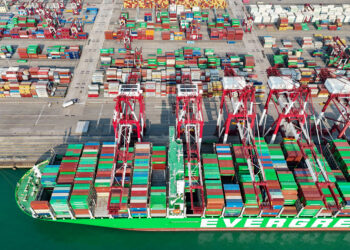Brussels – Tensions in the Middle East with ramifications in the Red Sea; the slowdown in China that affects demand and, therefore, exports of eurozone countries: the outlook is full of uncertainties and, in this context, the European Commission can only revise downward its growth estimates for 2024 and 2025. The winter economic forecasts show an almost half-a-point cut in the eurozone’s and the EU’s 2024 GDP. Eurozone growth of 0.8 percent this year, down from 1.2 percent expected in November and almost unchanged in 2025: 1.5 percent instead of 1.6 percent budgeted in the Autumn Economic Forecast.
Brussels cut its growth estimates for all member countries, starting with Germany. After the contraction in 2023 (-0.3 percent), the eurozone’s economic engine will continue to struggle this year and growth will be almost zero: just 0.3 percent, half a point lower than expected a few months ago (0.8 percent). Barring further complications, the German economy should rebound in 2025 (1.2 percent), for the sake of the eurozone, but in the meantime Germany’s slowdown is likely to produce negative effects for everyone.
In summary: “prospects for the first quarter of 2024 remain subdued,” the Union executive notes. “In the second half of this year, the pace of
growth is set to stabilize at cruising speed, broadly in line with potential, until the end of 2025.” Even the Commissioner for the Economy, Paolo Gentiloni, acknowledge that “the rebound expected in 2024 is set to be more modest than projected three months ago.”
-
- Crisis in the Red Sea
.
Brussels chooses the line of caution in a completely changed scenario with a blurred outlook. There is a mix of factors, all different and all potentially harmful, weighing on the EU and the euro area. “Geopolitical tensions, an ever more unstable climate and a number of crucial elections around the world this year are all factors increasing the uncertainty around this outlook,” Gentiloni summarizes. But among the main and most immediate risk factors is the crisis in the Red Sea.
The winter economic forecast devotes a small paragraph specifically to the situation in the area. Shipping through the Red Sea has been re-routed, resulting in longer shipping times and “skyrocketing
shipping costs.” Shipping times between Asia and Europe “increased by 10-15 days and freight costs
for containers on several China to Europe routes increased by around 400%. The disruption is affecting shipping
costs worldwide.” The risks that Gentiloni saw less than a month ago are becoming true.
-
- China’s slowdown weighs on exports
China’s slowdown also weighs on the economic weakness of the EU and eurozone countries. “The expected slowing of
growth in the US and China is weighing on demand,” but there is a particular focus on the Asian market. The EU executive recognizes that the Chinese economy “is at a critical stage.” It means that “A faster-than-expected retrenchment in economic activity, in the absence of a comprehensive reorientation of policies, could have negative growth spillovers to the EU economy.” The positive note, in this scenario, is an easing of price pressure, especially on energy commodities, which means lower inflation
-
- Drop in Inflation
.
The good news in these less-than-stellar economic forecasts comes from the inflation curve. The Commission cuts its forecasts for eurozone inflation in 2024 to 2.7 percent, from 3.2 percent in the November economic forecast. In 2025, it remains unchanged at 2.2 percent. Merit for a path has already begun in recent months. Lower energy commodity prices and weaker economic dynamics have put inflation on a lower downward path than expected, the EU Commission document reads.
English version by the Translation Service of Withub![L'UE annuncia revisioni al ribasso per le stime di crescita [foto: imagoeconomica]](https://staging.eunews.it/wp-content/uploads/2022/07/Imagoeconomica_1730466-scaled.jpg)





